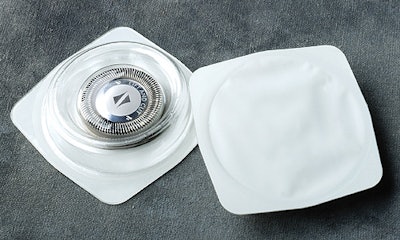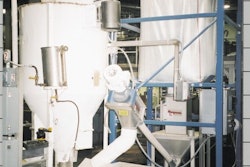Using recycled paperboard, a recyclable polyester blister, and a sealing system that doesn’t require heat, a new package from Philips Electronics meets environmental goals. At the same time, a new packaging line has helped the company improve output and reduce the labor necessary for packaging.
All of these benefits were gained by Philips a year ago when it switched packaging of its replacement shaver heads to the Ecobliss package, represented by Ecobliss North America. In the past, Philips used a folding card; glued together with hot melt, it enclosed a conventional clamshell containing the shaver heads. This style of packaging emerged when tamper-resistant packaging became a requirement in the United States. This requirement, in Philips’ case, resulted in a total package that was more expensive and not very environmentally friendly either.
In contrast, the Ecobliss package employs a fold-over card made of 100% recycled paperboard with graphics on one side only. The other side is screen printed with an exclusive Ecobliss cold-bond adhesive that only requires pressure for sealing. For the European market, Philips uses an 18-pt paperboard. For the packages to be shipped to North America, the firm employs a 36-pt board that, after printing, is overlaminated with a clear film of polypropylene. The board is printed in traditional four-color offset.
“We were introduced to the Ecobliss package concept at two trade fairs, one here in The Netherlands and another in France,” recalls Hugo Mosterman, initial buyer for Philips DAP at Drachten, The Netherlands. DAP refers to Philips’ Domestic Appliances and Personal Care products. “We found that Ecobliss could offer us an attractive alternative to our existing replacement-head package.
“This was not only in the package itself, but also for the complete packaging process. We liked the idea of a total concept—materials and equipment from a single source—and the choice was quickly made,” Mosterman recalls. “Of course, other important criteria in the selection process—cost, quality, and appearance—were not neglected. Under Ecobliss responsibility, a complete packaging line was developed and built for our plant.”
The new package was introduced last summer, first in the United States and later in the rest of the world, he reports. “Virtually everywhere you can buy our shaver, you can also buy our replacement heads. However, our main markets for the replacement heads are in the United States and in Western Europe.” The replacement heads can also be ordered via the Internet.
Dual-line packaging
Ecobliss general manager Marijn van Utteren described the unusual dual-style packaging line.
In essence, he says, there are two parallel packaging lines. But neither Philips nor Ecobliss chooses to identify machinery suppliers. One line thermoforms a “blister cup” that eventually becomes part of the Ecobliss package. The blister cup is created to individually pack the two-piece shaver heads.
“The reason for wanting to prepack the shaver heads was better product control,” van Utteren says. “Philips wanted the consumer to find the two-piece shaver heads assembled and ready to affix to the shaver, rather than having six loose pieces that had to be assembled. In addition, if the parts were loose, there could be some wear.” The individual blister cups also support the “quality feel” that Philips emphasizes to its customers.
Once the blisters are loaded and sealed with film, they move to what van Utteren calls a “buffer” area that allows the prepacks to be accumulated. “Mostly, the two lines operate simultaneously,” he says. “But it’s not like there’s a direct one-to-one link; each part of the process can operate independently.”
Card packaging
Paralleling the blister cup line is the line that includes the magazine-fed Ecobliss Speed Press. A label unit applies both acoustomagnetic and radio-frequency anti-pilfering labels to what will later become the inside of the card.
At a later station, a robotic head inserts the prepacked blister cups into the card. Then the cards are automatically folded over and moved under a platen-style pressure sealer. Once completed, the packages destined for North America receive six rivets to make the package absolutely pilfer-proof, according to Philips. No rivets are used for the European packages.
After the cards are discharged from the machine, they are conveyed to another robotic head that loads them into a folding carton.
One of the two principal advantages to the new packaging is that the package is considered more environmentally sound. “At Philips, we have signed a ‘green covenant’ that indicates we won’t use harmful materials in packaging our products,” Mosterman says. “The use of carton board and environment-friendly PET for the blisters meets this need.”
As Mosterman explains, Ecobliss is its first-tier main supplier, even though the supplier outsources parts of the business. “Ecobliss makes use of traditional packaging converters, and they’ve done the same with some production equipment,” he says. Neither Philips nor Ecobliss will identify them.
Despite the heavy carton material employed, Philips’ second advantage is gaining savings compared to what it was doing before. “The total production costs—including materials, process costs, [and so forth]—are lower when compared to the former package and process,” Mosterman states.
Or as van Utteren explains, Philips is enjoying higher production output while using less labor compared to the old situation. Plus, he says, the old method produced a lot of “running spoils” or scrap. So while Ecobliss may be outsourcing, Philips is doing anything but.
“Although packaging is not our core competence, we decided to keep this activity in-house,” Mosterman explains. “Because of the level of automation, our labor costs are relatively low, so we’re not forced to shift the production to third parties. We realized that the transport and control costs would far exceed the gain in labor costs.” Plus, for products retailing at $20 to $30 per set, Philips keeps tight control of the appearance of its packaging.
























